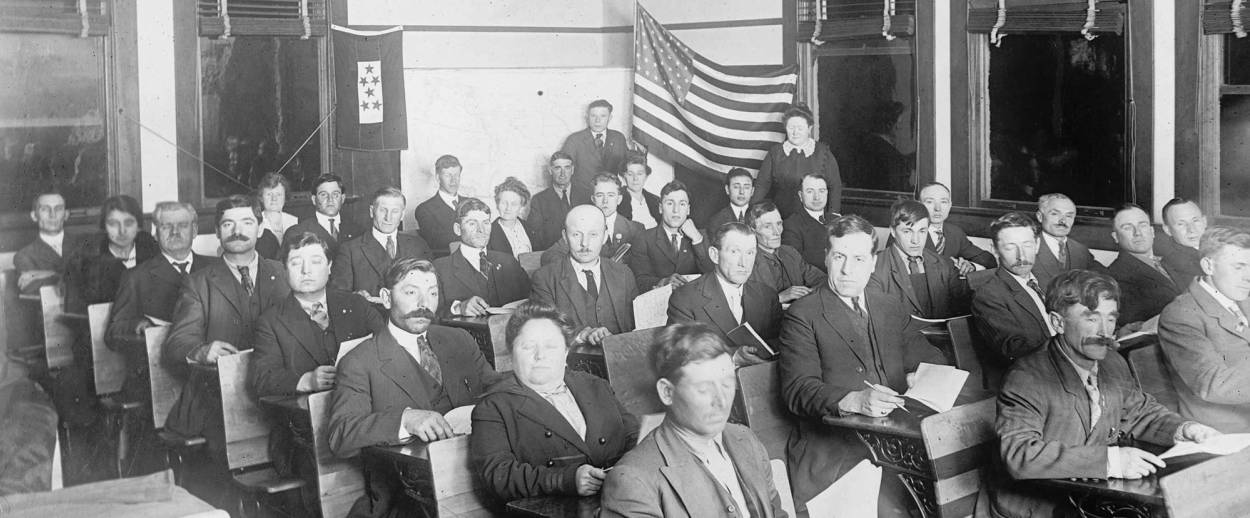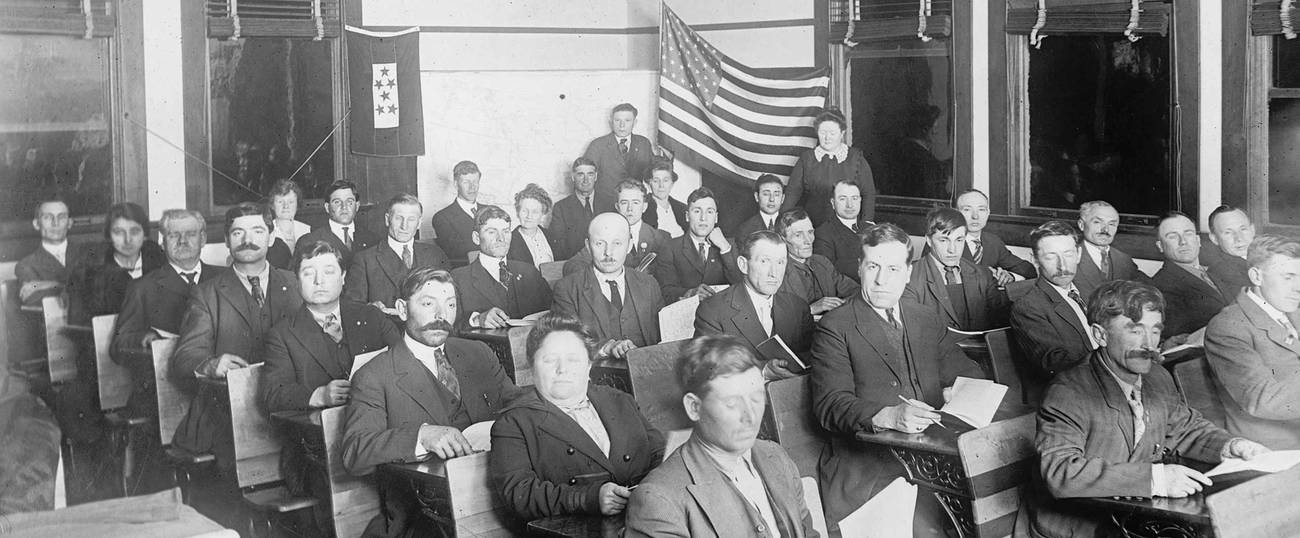Civics Lessons
How Jewish immigrants learned how to be American citizens




Who was the 16th president of the United States? What does it take to become a U.S. senator? This isn’t Trivial Pursuit, or Jeopardy—answering correctly is no game. In years gone by, knowing the identity of the 16th president and being aware of the prerequisites for a seat in the Senate rendered you a candidate for naturalization and, in the fullness of time, for citizenship.
Familiarity with American presidential and congressional history was once part and parcel of a body of knowledge known as “civics,” or, more pedagogically, as “citizenship education.” Taught in schools and in voluntary associations such as settlement houses, as well as circulated through the medium of guidebooks, or “manuals for citizenship” like those published by the Daughters of the American Revolution in Czech, Italian, Swedish, and Yiddish, it prepared both native-born and foreign-born residents of this country to take their place in American society.
Well into the early years of the 20th century, civics consisted primarily of basic knowledge about the “machinery of government,” especially on the federal level, and had little to do with the more proximate institutions of daily life. On the cusp of World War I, under the impress of urbanization, industrialization, and heightened levels of immigration, a number of educators increasingly began to employ a broader definition of civics: one rooted less in political science, not quite as “bookish,” and anchored more firmly, and practically, in American cultural norms.
Behavior, the acquisition of what G.V. Hiney, a Michigan social studies teacher, called the “commendable civic virtues”—helpfulness, responsibility, fairness, broadmindedness, punctuality, thrift, and kindness to animals among them—was a cornerstone of the “new civics.” Emphasizing “proper social deportment,” rather than governmental affairs, it expanded the notion of citizenship. “Upright behavior, not political participation,” explained historian Julie A. Reuben, “became the defining mark of a good citizen.”
Intended for Americans at large, the new version of citizenship education had particular resonance when it came to the Americanization of “aliens,” as immigrants were once called. “The Great War revealed clearly that America had not wholly succeeded in the role of melting-pot,” observed Howard C. Hill of the University of Chicago High School in the November 1918 issue of School Review. In response, “there has been a great increase in recent months in the attention and effort given to immigrant education and Americanization projects of all sorts.” Overhauling the curriculum, rendering it less an occasion for “memory work” and more an opportunity for engagement, was the result.
Exposing immigrant schoolchildren to what it meant to be a good citizen took place even earlier. In 1908, Julia Richman, the deputy superintendent of New York’s public schools, together with her sister, Isabel Richman Wallach, the author of A First Book in English for Foreigners, published Good Citizenship, a companionable account of the local institutions and practices that made up the common good. “It is far more important for the welfare of the state that a child should be made to realize his present obligations to the commonwealth than that he should know the qualifications of a United States senator,” the text declared, announcing its down-to-earth intentions.
Designed for students in the fourth grade as well as for adults in night school, the book introduced them to the people behind the police, fire, health and street-cleaning departments. Its tone nonthreatening, chatty, and even imaginative—young readers were encouraged to don “make-believe caps” that would place them behind the scenes and in the company of intrepid firemen and police officials—Good Citizenship sought to make government a friend, an ally, rather than an antagonist.
At every turn and on nearly every page, the authors touted the virtue of cooperation, of working in tandem with the local authorities, to see to it that the streets were kept free of fruit skins, nut shells, and other waste materials (“Surely this is not too much to ask!”); tenement fire-escapes were to be left unobstructed, and disease held at bay. “Sensible people ought always be on guard against all kinds of dirt, ready to fight it whenever they see its traces,” the text exhorted, deploying militaristic language. “Their best weapons are Cleaning and Keeping things clean.”
At once a manual and a manifesto, Good Citizenship held its readers accountable, enabling them to feel a part of, and responsible for, the smooth, healthy functioning of the social order.
While children were taught civics in the course of their schooling, their foreign-born parents had to seek out opportunities to be exposed to the latest civic wisdom. In large cities such as New York and Chicago, Cleveland and Boston, they were not hard to find. Social settlement houses, venues of informal education, such as the Chicago Hebrew Institute and New York’s Educational Alliance made a point of it.
At the Chicago Hebrew Institute, “civic training” was a central component of its “mission”—so much so that the “people’s institute,” as it was also called, maintained a Citizenship Bureau to guide prospective applicants through the cumbersome, multitiered process by which they might obtain their papers. A citizenship club in which the newest members of the body politic sought to encourage others within their circle of family and friends to follow suit furnished an additional incentive.
Miles away, in the Empire City, the Educational Alliance’s efforts at promoting citizenship, which encompassed classes in civics, hygiene, and English as well as the furnishing of “necessary information” on the “formalities,” elicited rave reviews. When, in 1902, William Maxwell, the superintendent of New York’s public schools, was called on to comment on the institution’s commitment to Americanization, he couldn’t resist a biblical turn of phrase: The Alliance, said he, was a “pillar of cloud by day and a pillar of fire by night to guide the dense population of this neighborhood through the desert of dirt and sordidness and sin into the promised land of cleanliness, independence, and happiness.”
Equally compelling, though far more prosaic and considerably less lofty, were guidebooks to citizenship. Often part of the curriculum of social service agencies, they could also be read, and their lessons absorbed, on one’s own. Consider John Foster Carr’s 1912 Guide to the United States for the Jewish Immigrant and the version on which it was based, Vegvayzer fun di Ferynigte Shtaaten far dem Idishin Imigrant, whose inclusion of a detailed map of the United States rendered the names of its mighty rivers and mountain ranges in Yiddish.
Nothing if not helpful, this how-to pamphlet, which cost 20 cents, encouraged the newly arrived to learn English as fast as they could (“it is the door to American life and citizenship”); to become citizens of the United States as soon as possible “(it is the first duty of gratitude to the land that has welcomed you”); and to eat well, avoid strong drink, save money, bathe every day, and sleep with the windows open.
Despite the sensible advice it imparted and its revamped, modernized orientation, civic education was not without its frustrations. Many texts, observed one of the genre’s critics, remained a “hodge-podge of material, good, bad, and indifferent.” In other instances, the literature was still too narrowly focused, the utility of its information questionable. How valuable could it be to know that the “Senate Chamber is 113 feet, 3 inches in length by 80 feet, 3 inches in width, and 36 feet in height?”
And in still other instances, citizenship education tended to be rather heavy handed, even coercive. There’s no question that some of its considerations were insensitive, tone deaf, to the many obstacles that stood in the way of becoming a citizen. What’s more, civics presumed that the desired objective was a speedy and thoroughgoing Americanization rather than a blend of old world traditions with new world practices.
And yet, for all its limitations, at its very core lay the belief that a person’s place of birth, of origin, should not—and would not—stand in the way of his or her becoming a full-fledged American. Citizenship was within reach rather than foreclosed. When seen from this perspective, the discourse of civics was an exercise in hopefulness, a testament to the malleability of the human condition.
By the way, to be a United States senator one has to be at least 30 years old, a citizen of this country for at least nine years, and a resident of the state that the would-be senator hopes to represent. Oh, and the 16th president of the United States was Abraham Lincoln.
***
Like this article? Sign up for our Daily Digest to get Tablet magazine’s new content in your inbox each morning.
Jenna Weissman Joselit, the Charles E. Smith Professor of Judaic Studies & Professor of History at the George Washington University, is currently at work on a biography of Mordecai M. Kaplan.